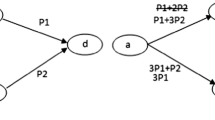Abstract
In opportunistic networks, sensor communication areas are established by node movements. Information can be transmitted among communication areas. Relevance nodes in communication areas are important because they carry information and build bridges between areas and data packets so that information can be delivered to the destination node. This study proposes a routing algorithm called sensor communication area node extend (SCANE), which aims to select relevance nodes and to recombine communication areas. This algorithm also enables information to be transmitted from the start node to the destination node easily. The simulation indicates that compared with Epidemic, PRoPHET, and Spray and wait algorithms in opportunistic networks, the proposed algorithm improves delivery ratio, overhead, and delay time.





Similar content being viewed by others
References
Hu Y, Liu A (2015) An efficient heuristic subtraction deployment strategy to guarantee quality of event detection for WSNs[J]. Comput J 58(8):1747
Conti M, Kumar M (2010) Opportunities in opportunistic computing[J]. Computer 43(1):42–50
Ristanovic N, Theodorakopoulos G, Le Boudec JY (2013) Traps and pitfalls of using contact traces in performance studies of opportunistic networks[C]//INFOCOM, 2012 Proceedings IEEE. IEEE 1377–1385
Wu J, Chen Z (2016) Data decision and transmission based on mobile data health records on sensor devices in wireless networks[J]. Wirel Pers Commun 1–15
Ma HD, Zhao D, Yuan PY (2014) Opportunities in mobile crowd sensing. IEEE Commun Mag 52(8):29–35. doi:10.1109/MCOM.2014.6871666
Dong M, Ota K, Yang LT, Liu A, Guo M (2016) LSCD: a low-storage clone detection protocol for cyber-physical systems. IEEE Trans CAD Integr Circuits Syst 35(5):712–723
Dong M, Ota K, Li H, Du S, Zhu H, Guo S (2014) RENDEZVOUS: towards fast event detecting in wireless sensor and actor networks. Computing 96(10):995–1010
Cheng H, Sun F, Buthpitiya S, Griss M (2012) SensOrchestra: collaborative sensing for symbolic location recognition. Mobile Comput Appl Serv 76:195–210. doi:10.1007/978-3-642-29336-8_11
Toledano E, Sawaday D, Lippman A, Holtzman H, Casalegno F (2013) CoCam: a collaborative content sharing framework based on opportunistic P2P networking. In: Proc. of the IEEE CCNC 2013 158–163. doi:10.1109/CCNC.2013.6488440
Cheong M, Lee VCS (2011) A microblogging-based approach to terrorism informatics: exploration and chronicling civilian sentiment and response to terrorism events via Twitter[J]. Inf Syst Front 13(13):45–59
Han B, Pan H, Kumar A (2012) Mobile data offloading through opportunistic communications and social participation. IEEE Trans Mobile Comput 11(5):821–834. doi:10.1109/TMC.2011.101
Rajan RT, Alle-Jan VDV (2015) Joint ranging and synchronization for an anchorless network of mobile nodes[J]. IEEE Trans Signal Process 63(8):1925–1940
Dong M, Ota K, Liu A, Guo M (2016) Joint optimization of lifetime and transport delay under reliability constraint wireless sensor networks. IEEE Trans Parallel Distrib Syst 27(1):225–236
Lee VCS, Yang X (2005) Development and test of an artificial-immune- abnormal-trading-detection system for financial markets[C]// advances in intelligent computing, international conference on intelligent computing, Icic 2005, Hefei, China, August 23–26, 2005, Proceedings. 410–419
Chilipirea C, Petre AC, Dobre C et al (2015) A simulator for analysis of opportunistic routing algorithms[C]//2015 14th International Symposium on Parallel and Distributed Computing. IEEE 27–36
Ramanathan R, Hansen R, Basu P et al (2007) Prioritized epidemic routing for opportunistic networks[C]//Proceedings of the 1st international MobiSys workshop on Mobile opportunistic networking. ACM 62–66
Spyropoulos T, Psounis K, Raghavendra CS (2005) Spray and wait: an efficient routing scheme for intermittently connected mobile networks[C]//Proceedings of the 2005 ACM SIGCOMM workshop on Delay-tolerant networking. ACM 252–259
Wang G, Wang B, Gao Y (2010) Dynamic spray and wait routing algorithm with quality of node in delay tolerant network[C]//Communications and Mobile Computing (CMC), 2010 International Conference on. IEEE 2010(3):452–456
Toledano E, Sawaday D, Lippman A, Holtzman H, Casalegno F (2013) CoCam: a collaborative content sharing framework based on opportunistic P2P networking. In: Proc. of the IEEE CCNC 2013 158–163
Zhuo XJ, Li QH, Gao W, Cao GH, Dai YQ (2011) Contact duration aware data replication in delay tolerant networks. In: Proc. of the IEEE ICNP 2011 236–245
Koukoumidis E, Peh L, Martonosi M (2011) SignalGuru: leveraging mobile phones for collaborative traffic signal schedule advisory. In: Proc. of the ACM MobiSys 2011 27–140
Ra M, Liu B, Porta T, Govindan R (2012) Medusa: a programming framework for crowd-sensing applications. In: Proc. of the ACM MobiSys 2012 337–350
Yang Y, Gao Z, Zhou H, Qiu X (2014) An uncertainty-based distributed fault detection mechanism for wireless sensor networks. Sensors 14:7655–7683
Granovetter MS (1973) The strength of weak ties[J]. Am J Sociol 78(6):1360–1380
Acknowledgments
This work was supported in part by the National Natural Science Foundation of China(61379057,61309001,61272149);
Doctoral Fund of Ministry of Education of China(20120162130008);
Innovation Foundation For Postgraduate(2014zzts043).
Author information
Authors and Affiliations
Corresponding author
Rights and permissions
About this article
Cite this article
Wu, J., Chen, Z. Sensor communication area and node extend routing algorithm in opportunistic networks. Peer-to-Peer Netw. Appl. 11, 90–100 (2018). https://doi.org/10.1007/s12083-016-0526-4
Received:
Accepted:
Published:
Issue Date:
DOI: https://doi.org/10.1007/s12083-016-0526-4




